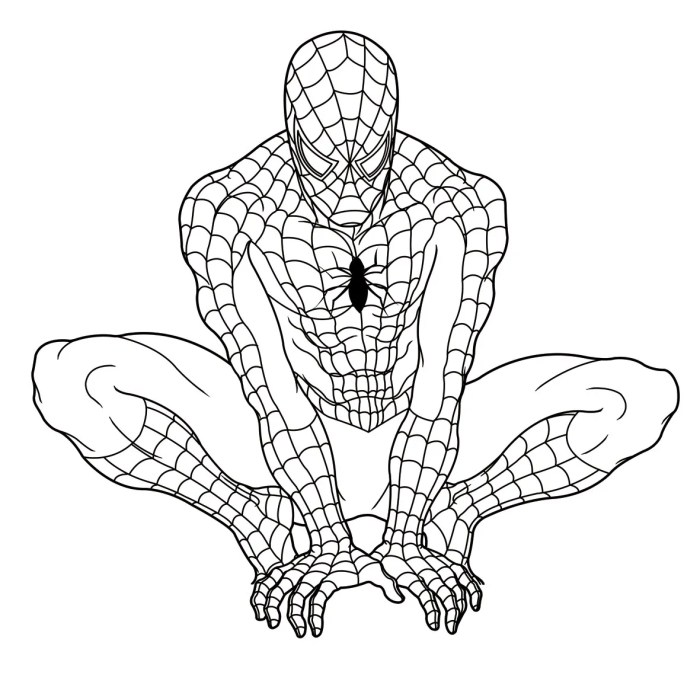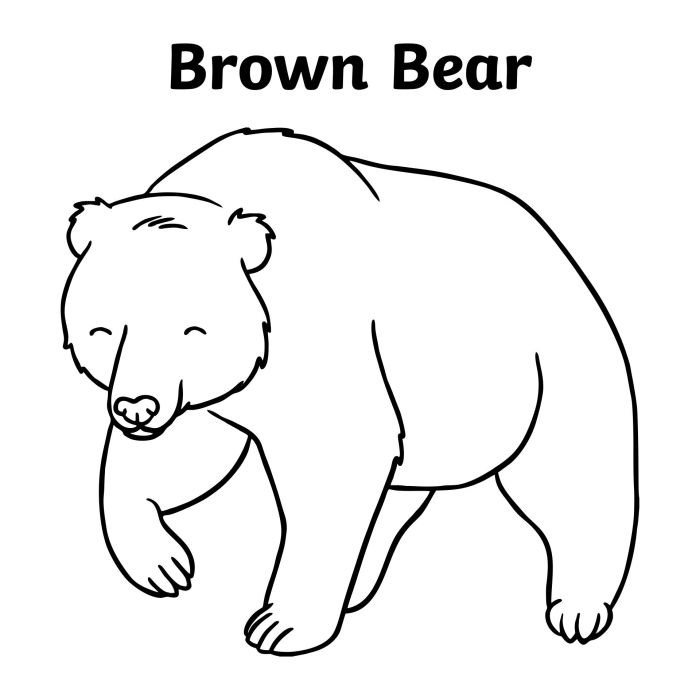Design and Content Exploration

Spider man coloring book – This section details the design considerations and content choices for a Spiderman coloring book, focusing on cover options, character selection, coloring page styles, and page layout examples. A successful coloring book requires a captivating design and engaging content that appeals to the target audience.
Cover Design Options
Three distinct cover designs are proposed to appeal to a broad range of children. The covers utilize different artistic styles and color palettes to create visually appealing options.
- Cover 1: Classic Comic Book Style: This cover features a dynamic pose of Spiderman, rendered in a bold, graphic style reminiscent of classic comic book covers. The color palette is vibrant, using primary colors and strong contrasts. The title “Spider-Man Coloring Book” is prominently displayed in a stylized font that echoes the comic book aesthetic. A small, secondary image, perhaps a villain’s silhouette, might be subtly included in the background to add intrigue.
- Cover 2: Photorealistic Spiderman: This cover showcases a highly detailed, photorealistic illustration of Spiderman in action, perhaps swinging through a cityscape at night. The colors are more muted and realistic, utilizing a darker, more atmospheric palette. The title is presented in a clean, modern font, contrasting with the detailed image. This approach offers a more mature and sophisticated look.
- Cover 3: Cartoonish Spiderman: This cover adopts a playful, cartoonish style, depicting a smiling Spiderman in a fun, energetic pose. Bright, cheerful colors are used throughout. The title is displayed in a large, friendly font, potentially incorporating playful elements like speech bubbles or spiderwebs. This option is aimed at younger children.
Spiderman Characters for Inclusion
The selection of characters is crucial for engaging readers. This list ensures a balanced representation of iconic figures and supporting characters, appealing to different preferences and levels of familiarity with the Spiderman universe.
Spider-Man coloring books are a popular choice for young fans of the web-slinger, offering hours of creative fun. These books often feature dynamic action scenes and iconic characters, making them a great way to engage children’s imaginations. For a wider selection of exciting themes and characters, you might also want to check out other options in the broader category of coloring books for kids.
Ultimately, though, a Spider-Man coloring book remains a fantastic gift for any budding artist who loves superheroes.
- Spider-Man (Peter Parker)
- Miles Morales
- Gwen Stacy (Spider-Gwen)
- Mary Jane Watson
- Aunt May
- Green Goblin
- Doctor Octopus
- Venom
- Carnage
- Electro
- The Lizard
Coloring Page Styles, Spider man coloring book
Diverse coloring page styles cater to different skill levels and preferences. A mix of simple and complex designs ensures broad appeal.
- Simple Designs: These pages feature basic Artikels of Spiderman and other characters, ideal for younger children or beginners. They provide large areas for coloring, promoting creativity without being overwhelming.
- Intricate Details: These pages contain more detailed line art, including intricate web patterns, textures on costumes, and background elements. They challenge older children and experienced colorists.
- Scenes: These pages depict dynamic scenes featuring Spiderman in action, such as fighting villains or swinging through the city. They allow for more creative storytelling and color choices.
Sample Page Layout
This example illustrates a potential page layout combining image and text elements.
The page would be divided into two main sections. The left side would feature a large, detailed coloring image of Spiderman battling Doctor Octopus amidst a cityscape backdrop. The right side would contain a smaller, simpler coloring image of a friendly neighborhood Spiderman waving to children. At the bottom of the page, a short descriptive sentence would be included: “Help Spiderman defeat Doctor Octopus and bring smiles to the neighborhood!”
Competitive Analysis
This section analyzes three existing Spiderman coloring books to identify their strengths, weaknesses, innovative features, and potential underserved niches within the market. This analysis will inform the design and development of a superior Spiderman coloring book.
Comparison of Three Spiderman Coloring Books
To conduct a thorough competitive analysis, three distinct Spiderman coloring books were selected, representing different approaches to the market. These books varied in their art style, complexity, and target audience. The analysis focuses on identifying best practices and areas for improvement. For example, Book A, focused on younger children, featured simpler designs and larger spaces for coloring.
Book B, aimed at slightly older children, presented more intricate illustrations and a greater variety of characters. Finally, Book C, marketed to collectors, showcased high-quality printing and a more sophisticated art style.Book A: Strengths include its simplicity and suitability for younger children. Weaknesses include the limited complexity of the designs, which may not appeal to older children.Book B: Strengths include a wider range of character depictions and more complex designs.
Weaknesses include smaller coloring spaces, potentially making it challenging for younger children.Book C: Strengths include high-quality printing and a sophisticated art style. Weaknesses include the price point, which may be prohibitive for some consumers, and a limited number of pages.
Innovative Features in Competitor Coloring Books
Several competitor coloring books incorporate innovative features to enhance the user experience. For instance, some books include augmented reality (AR) elements, allowing users to interact with the illustrations through a smartphone or tablet. Others incorporate elements of storytelling or interactive games, transforming the coloring experience into a more engaging activity. Finally, some books feature perforated pages, allowing users to easily remove and display their finished artwork.Examples include interactive elements such as hidden images revealed through coloring, perforated pages allowing for easy framing, and the incorporation of stickers or additional activities alongside the coloring pages.
Unserved Niches in the Spiderman Coloring Book Market
Despite the existing market, certain niches remain underserved. There is a potential opportunity for a coloring book focused on specific Spiderman storylines or events, offering a more narrative-driven experience. Furthermore, a coloring book incorporating elements of environmental awareness or social responsibility, aligning with Spiderman’s values, could attract a new segment of consumers. Finally, a coloring book tailored to older teens and adults, featuring more intricate and detailed illustrations, could also fill a gap in the market.
A high-quality, adult-oriented book with detailed, sophisticated designs could tap into the adult coloring book market’s success.
Potential Improvements to Existing Spiderman Coloring Book Designs
Several improvements could enhance the design of existing Spiderman coloring books. For example, incorporating higher-quality paper stock could improve the coloring experience and the longevity of the book. Using more vibrant and detailed illustrations could increase visual appeal. Including bonus content, such as stickers, stencils, or additional activities, could add value and engagement. Finally, designing pages with a variety of complexity levels would cater to a wider range of ages and skill levels.For example, incorporating a section with larger, simpler images for younger children alongside more intricate designs for older children would significantly broaden the appeal of the coloring book.
Additional Features: Spider Man Coloring Book

Enhancing the Spider-Man coloring book beyond simple coloring pages can significantly boost its appeal and market value. Adding interactive elements and bonus content provides a more engaging and complete experience for young fans. Careful consideration of paper type and binding method also contributes to the overall quality and longevity of the product.
Interactive Elements
Including interactive elements transforms a passive coloring experience into an active, playful one. Stickers featuring Spider-Man characters and iconic imagery could be incorporated, allowing children to personalize their creations further. Simple, Spider-Man themed puzzles, perhaps a jigsaw puzzle or a connect-the-dots activity, could be integrated directly into the book, providing additional entertainment beyond coloring. These interactive additions cater to different learning styles and keep children engaged for longer periods.
Paper Type Comparison
The choice of paper significantly impacts the coloring experience. Different paper types offer varying weights, textures, and suitability for different coloring mediums.
| Paper Type | Weight (gsm) | Texture | Suitability |
|---|---|---|---|
| Standard Printing Paper | 70-80 | Smooth | Suitable for crayons and colored pencils, may bleed with markers. |
| Cardstock | 160-200 | Slightly textured | Ideal for various mediums, minimizes bleed-through. |
| Drawing Paper | 90-160 | Slightly textured to rough | Good for pencils, crayons, and watercolors; thicker varieties reduce bleed-through. |
| Specialty Coloring Paper | 100-200+ | Smooth to textured, often with a coating | Designed to minimize bleed-through and feathering, works well with markers and watercolors. |
Bonus Content
Supplementing the coloring pages with additional content increases the overall value and longevity of the book. This extra material caters to a child’s curiosity and extends the engagement beyond just coloring.
A selection of Spider-Man facts, including his origin story, powers, and notable villains, would be a fascinating addition. Simple activities, such as mazes, word searches, or “spot the difference” games featuring Spider-Man characters and settings, would provide further entertainment and educational value. A small section dedicated to coloring tips and techniques could also prove beneficial for young artists.
Binding Methods
The binding method directly affects the book’s durability, ease of use, and overall presentation.
Several binding methods are suitable for coloring books, each with its own advantages and disadvantages:
- Saddle Stitch Binding: Pages are folded in half and stapled along the spine. This is a cost-effective method, but it’s suitable only for thinner books. The pages can easily tear out, especially with frequent use.
- Perfect Binding: The pages are glued together along the spine, creating a flat, smooth edge. This method allows for thicker books, but the spine can be prone to cracking with repeated use.
- Spiral Binding: Pages are punched with holes and bound together with a plastic or metal coil. This allows for the book to lay flat, but the binding can be bulky and prone to snagging.
- Case Binding: This is a more robust method, where the pages are sewn together and then encased in a hardcover. This results in a durable and professional-looking book, but it’s the most expensive option.



